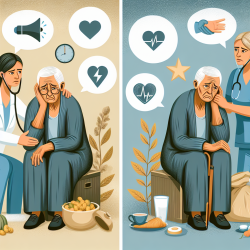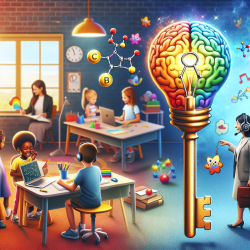Introduction
The recent study titled "Expanded phenotypic spectrum of neurodevelopmental and neurodegenerative disorder Bryant-Li-Bhoj syndrome with 38 additional individuals" offers significant insights into Bryant-Li-Bhoj Syndrome (BLBS), a complex neurodevelopmental disorder. This blog aims to distill the findings of this research for practitioners in speech-language pathology and related fields, emphasizing the importance of data-driven decisions in improving outcomes for children affected by this condition.
Understanding BLBS
Bryant-Li-Bhoj Syndrome is characterized by developmental delay, intellectual disability, craniofacial anomalies, and abnormal neuroimaging findings. The syndrome is linked to germline variants in the H3-3A/H3F3A and H3-3B/H3F3B genes, which encode the histone H3.3 protein. These genetic variants contribute to the phenotypic heterogeneity observed among individuals with BLBS.
Key Findings from the Study
The study expands the phenotypic spectrum of BLBS by analyzing data from 96 individuals, including 38 previously unpublished cases. The research highlights several critical points:
- Genetic Variability: The study identifies causative missense, synonymous, and stop-loss variants, underscoring the genetic complexity of BLBS.
- Phenotypic Heterogeneity: Despite having the same genetic variant, individuals can exhibit different phenotypes, suggesting additional factors may influence the disorder's presentation.
- Gene and Variant Location: The study suggests that the severity of BLBS phenotypes is more influenced by the location of variants within the H3.3 protein and the specific gene affected (H3-3A or H3-3B) than by the sex of the individual.
Implications for Practitioners
For practitioners, these findings highlight the importance of a comprehensive and individualized approach to diagnosis and intervention. Here are some practical takeaways:
- Genetic Testing: Encourage genetic testing for children exhibiting symptoms of BLBS to identify specific variants and tailor interventions accordingly.
- Interdisciplinary Collaboration: Work closely with geneticists and other healthcare professionals to understand the genetic underpinnings of each case and develop effective treatment plans.
- Continuous Monitoring: Given the phenotypic variability, regular assessments are crucial to adjust therapeutic strategies as the child develops.
Encouraging Further Research
The study underscores the need for further research to explore the potential gene-environment interactions and other factors that may contribute to the phenotypic variability of BLBS. Practitioners are encouraged to participate in research initiatives and contribute clinical data to enhance our understanding of this complex disorder.
Conclusion
By leveraging the insights from this study, practitioners can improve diagnostic accuracy and intervention strategies for children with Bryant-Li-Bhoj Syndrome. The ongoing collaboration between researchers and clinicians will be vital in unraveling the complexities of this disorder and improving outcomes for affected individuals.
To read the original research paper, please follow this link: Expanded phenotypic spectrum of neurodevelopmental and neurodegenerative disorder Bryant-Li-Bhoj syndrome with 38 additional individuals.










